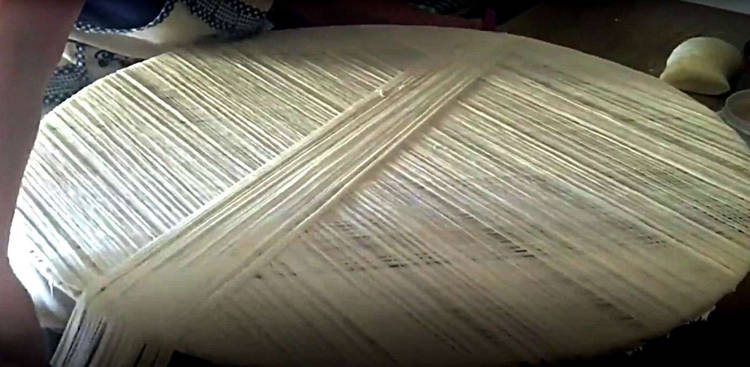The small town of Nuoro, on Italy’s Sardinia island, is home to what many are calling the world’s rarest pasta, an intricate, hand-made treat that only a handful of people can make.
Known as su filindeu (in Sardinia’s Sardo dialect), or Fili di Dio (in Italian), and translated as threads of God, this traditional pasta had been linked to La Festa di San Francesco, an ancient religious ritual celebrated every year, in May. For the past two hundred years, the only way to try threads of god pasta was to complete a 33km pilgrimage on foot or horseback from Nuoro to the village of Lula. But because this sacred dish is in serious danger of becoming extinct, the only three women in the world who know how to make it, have been trying to save it by making it more accessible.
67-year-old named Paola Abraini picked up the skills to make threads of god pasta from her mother, who also learned them from her mother, and so on for many generations. However, only one of her two daughters knows the basic technique, but lacks the passion and the patience necessary to carry on the family tradition. The only other two women who she managed to pass on her knowledge to – Abraini’s niece and her sister-in-law – don’t have any daughters to pass the secrets to, so su filindeu is in grave danger of vanishing.

Photo: screenshot
In recent years, Paola Abraini became so desperate to save the pasta she so loves that she went to local authorities asking her to help set up a school for girls willing to become su filindeu makers. They told her there was no money for schools, so she decided to invite girls into her home and teach them. That didn’t go well either, because making the threads of god isn’t the easiest thing in the world.
“It didn’t go well,” Abraini told the BBC, in 2015. “The problem was that once they saw how I actually do it, they’d say, ‘It’s just too much work’, and wouldn’t come back.”
View this post on Instagram
But she refuse to give up, and has since been invited to Rome to showcase her su filindeu making skills, by food and wine magazine Gambero Rosso. She also started making the rare pasta for several restaurants in the Italian capital to have it served to non-pilgrims for the first time, all in an attempt to save the rare dish.
But why is threads of god pasta so difficult to make? It only consists of three ingredients – semolina flower, water and salt – but because everything is made by hand, it’s the process itself that’s grueling. After mixing the ingredients, the dough is kneaded for a very long time to stretch the gluten, the key to making the extremely long and thin strands. Once it’s flexible enough, the stretching begins.
View this post on Instagram
Paola Abraini rolls the dough into 8 long, thin strands, then folds them, cuts them in half and stretches them again. The process is repeated 32 times, until 256 extremely thin threads of pasta are obtained. Just to get an idea of how thin the pasta gets, they are about half as thin as the more well known angel hair pasta.
Then the strands are stretched over a round, flat tray called a fundu in three overlapping layers, and left in the sun for a few hours, to dry. The layers of pasta stick together, thus creating a fabric-like design. Pieces of this edible tapestry are then broken and cooked.
View this post on Instagram
The process is easy enough to understand, but getting it just right has apparently been a problem for most people, even seasoned cooks.
“Many people say that I have a secret I don’t want to reveal,” Abraini told the BBC. “But the secret is right in front of you. It’s in my hands.”
In 2015, a team of engineers from internationally-known pasta brand Barilla visited the threads of god master, hoping to find ways of reproduce the pasta with a machine. They apparently failed. Then, chef superstar Jamie Oliver visited Abraini and tried to learn her technique, but gave up after two hours of trying. And these are only the most notable examples, hundreds others have tried and failed.
According to Slow Food International’s Ark of Taste, a project that aims to classify and preserve the world’s most endangered culinary traditions, out of the nearly 4,000 listed items, su filindeu is both the world’s rarest and most endangered pasta.
“This is one of the most at-risk foods of becoming extinct, in large part because it’s one of the most difficult pastas to make that exists, said Raffaella Ponzio, head coordinator of Ark of Taste.

 (@antonellafancello)
(@antonellafancello)




